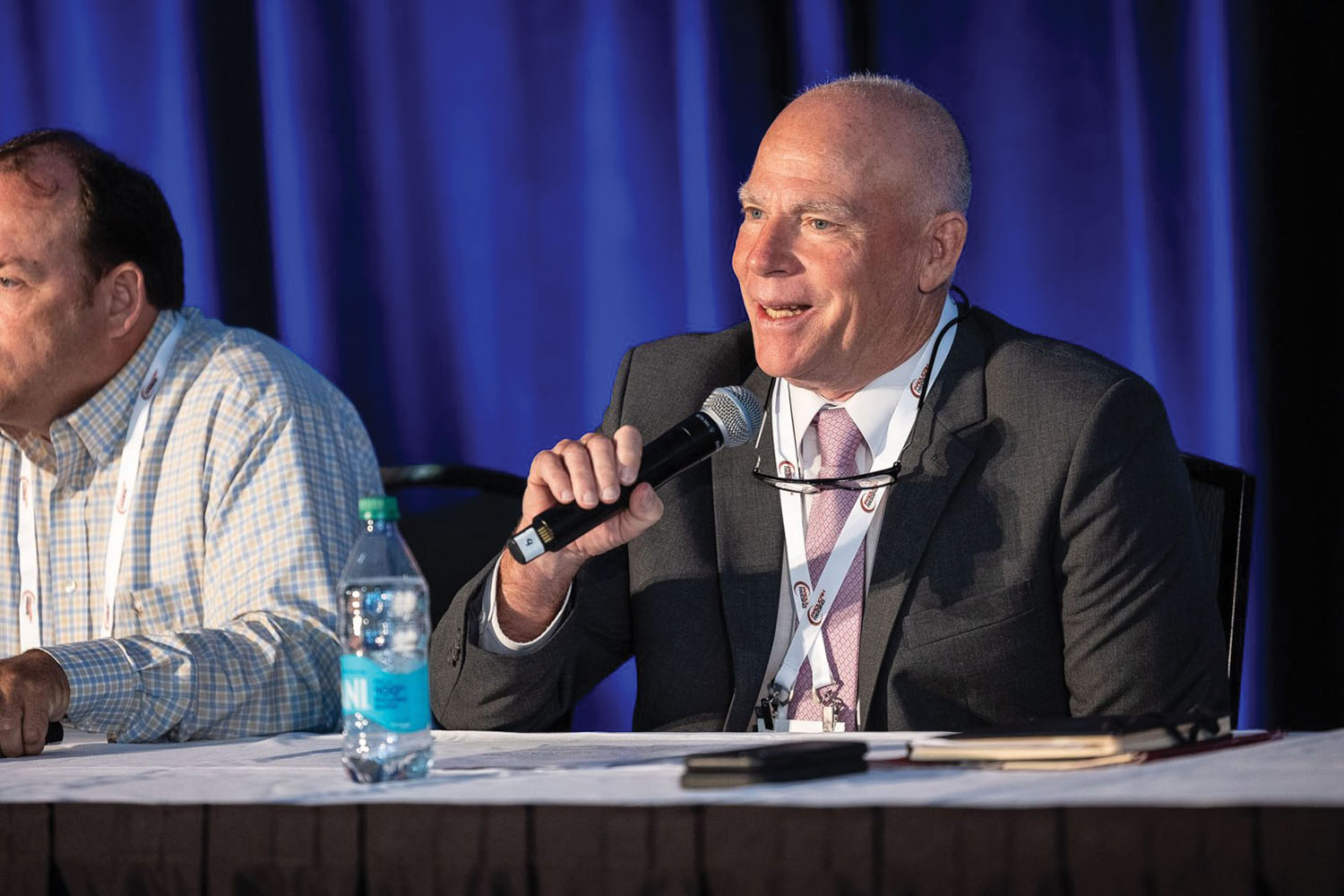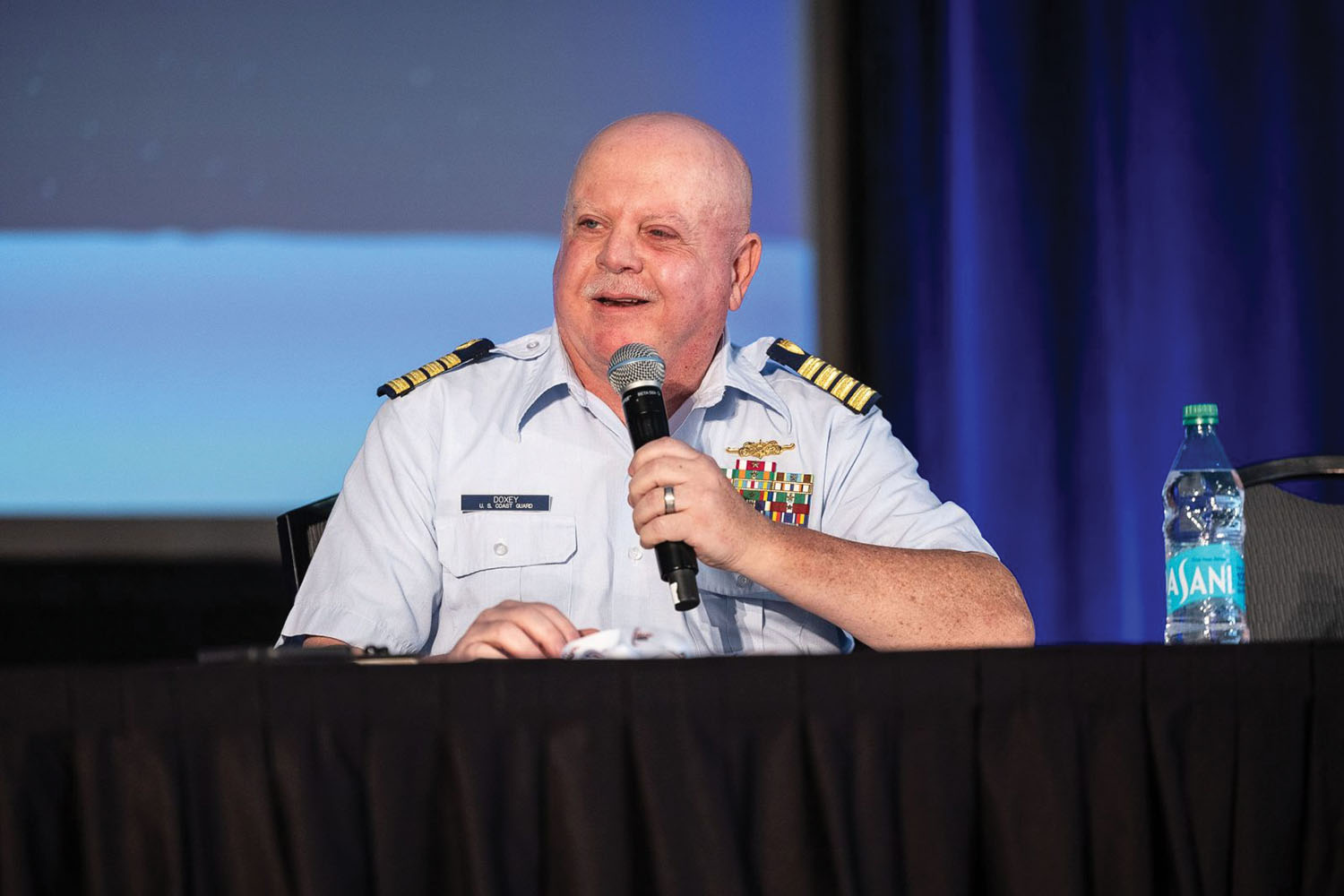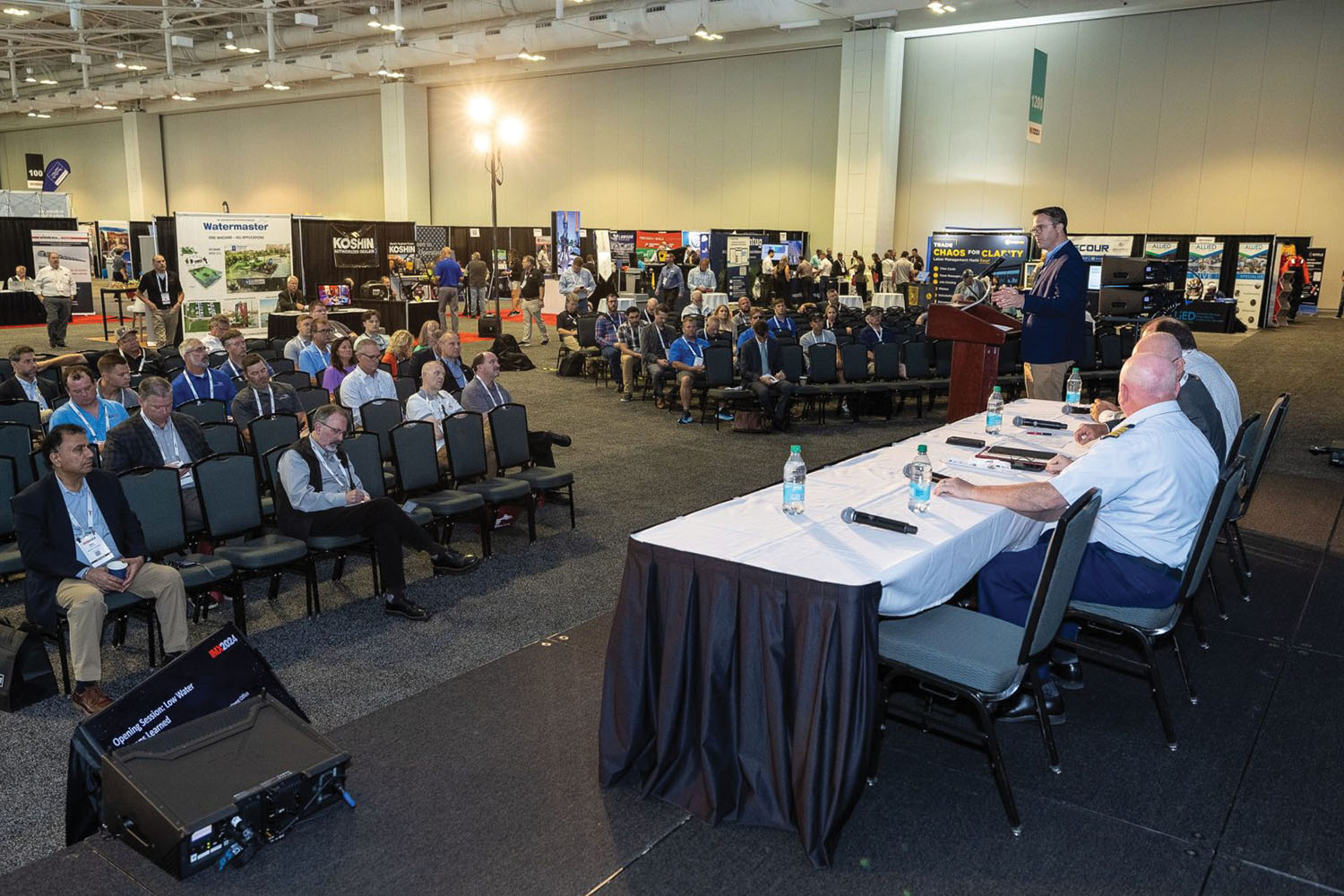From 2022 until earlier this year, the western rivers for much of the time hovered near historic low water levels. And yet, navigation impacts were far more onerous in 2022 compared to 2023.
A panel of waterway experts who spoke during the opening session of IMX 2024, held May 29-31 in Nashville, Tenn., attributed that improvement to lessons learned, proactivity and close communication and collaboration between the maritime industry and federal agencies.
Justin Lampert, director of the American Waterways Operators (AWO) mid-continent office, moderated the discussion. Other panelists included Pat Chambers, operations and regulatory division chief for the Mississippi Valley Division; Randy Chamness, vice president of vessel operations for American Commercial Barge Line (ACBL); and Capt. Keith Doxey, director of western rivers and waterways for the U.S. Coast Guard Eighth District.
Lampert led out by highlighting the contrast between 2022 and 2023.
“I think it’s safe to say, at least from an industry standpoint, that the impacts on navigation were reduced [in 2023] compared to 2022’s low water,” he said. “What do you think the biggest change was in 2023 that improved navigation reliability compared to the low water we had in 2022?”
Chamness pointed to three contributing factors.
“Most importantly, the proactive dredging,” he said. “The Corps was able to activate a dredge sooner than what we did the previous year. Typically we wait ’til we have a critical area, whereas this time we were able to get started a little earlier.”

Chamness added that, while the Mississippi River is dynamic and challenging, waterway stakeholders can nevertheless anticipate common problem areas.
“We know where some of the suspect places are going to be,” he said, “so we knew where we needed to focus our efforts first. Thanks to Pat and his team, they were able to do that.”
Queue management was also a big factor, Chamness said, particularly the manner in which industry and the Corps partnered to manage vessel traffic through problem areas.
“In the past, we’ve seen these vessel queues get to 100-plus boats, and this last year, we didn’t see that,” Chamness said. “I think we had two queues that got to 50-plus boats, and that was because of the way we did queue management on site. And when I say ‘on site,’ I don’t mean in a command center on the bank. I mean actually on the dredge itself. … That paid off in spades.”
Lastly, Chamness celebrated the fact that the Corps was able to have three main dredges working hotspots in the river: the government-owned dustpan dredges Hurley and Jadwin and Pine Bluff Sand & Gravel’s dustpan dredge Wallace McGeorge.
“Having that third dredge was a huge win for us, really helped us and, I think, was a game changer,” Chamness said.
Chambers said a huge part of the Corps’ proactive dredging in 2023 had to do with proactive funding.
“Normally what we’re dredging and what we do for our inland waterway dredging is just-in-time dredging, because that’s what we’re funded to do,” said Chambers, who added that wasn’t the case in 2023. “We had money up front. We got out early. We didn’t waver. We didn’t second guess. We just said, ‘Well, if we’re early and it’s too soon, that’s fine. We’re going to go ahead and do it.”
Chambers said Corps officials plan to take the same approach if extreme low water conditions return in 2024.

Aids To Navigation
Doxey said, from a Coast Guard perspective, the agency tried to be proactive with maintenance and replacement of aids to navigation (ATONs) in order to keep the channel marked and, hopefully, avoid groundings.
“We actually renewed our ATON buoy contract, and we dedicated an additional $6 million to getting more buoys on the river system,” Doxey said.
Doxey said ATON maintenance is a huge challenge for the Coast Guard, which faces an enormous number of lost or displaced buoys each year.
“It looks like we lose about 50 percent of our river buoys every year, so I have to buy about 50 percent of the inventory every year,” Doxey said. “That’s about $5 million-plus every year that I have to invest. … I just want people to know how difficult it is to purchase things in advance for the Coast Guard. We have to have analytics, and we rely on that to get the demand signal.”
Further complicating that buoy replacement task is the Coast Guard’s aged buoy tender fleet.
“They do break down, and we have something called obsolescence,” Doxey said. “We don’t have parts that we have to have fabricated to get things up and running.”
Still, Doxey said the Eighth District tries to be as nimble as possible with personnel and assets.
“We do have surge capacity to help load, pre-stage and get supplies where they need to be,” he said.
Doxey said the agency is in the midst of recapitalizing its waterways commerce cutter, or buoy tender, fleet, although the current projection for cutting steel on the first vessel is October 2025.
Chambers said the Corps is in a similar boat with its dustpan dredge fleet.
“Two of [the dustpan dredges] we use on the main stem Mississippi are 90 years old, going on 91 now,” he said. “They’re old, and we’ve got to work to replace those. We’re working that now. We’ve got estimates on them, and we’re working through our Marine Design Center to get those designed and built. There are some obstacles, funding being No. 1.”
Lampert mentioned the Lower Mississippi River Comprehensive Management Study, which is a five-year mega study to evaluate the Corps of Engineers’ entire approach to managing the Mississippi River and its tributaries, much like the “project flood” that followed the Great Flood of 1927. Lampert specifically asked Chambers if the Corps is “committed to maintaining a 12-foot channel” from Cairo, Ill., to the Gulf, consistent with the authorization in the Flood Control Act of 1944.
In response, Chambers pointed out that, the vast majority of the time, the Mississippi River is at or above 12 feet deep. Keeping it there, he said, will depend on the dredge fleet and appropriations.
“We’re definitely committed to maintaining what Congress funds us to maintain,” Chambers said. “I know everybody’s laughing at that because, what a political answer. What we’re funded to maintain, we’re going to.”
Chambers said Corps officials are currently assessing how best to determine the environmental and economic feasibility of deepening the river’s shallow-draft channel from 9 to 12 feet, whether through a full-blown environmental impact statement or a supplemental.
Chamness argued that, based on market pressures for U.S. grain exports, the economic case is definitely there.
“When you look at a dry cargo barge, every inch of draft is 17 to 18 tons,” Chamness said. “When you’re getting the percent tariffs we were seeing in the 700 or 800 percent and north range, the pressure was there on all of us to move every ton we could move.”
It’s a balancing act, Chamness said, between maximizing every inch of draft possible and avoiding loading barges too deep for the available draft. What’s more, with it taking a tow four to six days to move through the system, draft conditions can change mid-transit.
“That’s the industry’s biggest challenge, properly and adequately changing our drafts to, not only fit our own company, but also fit what we can safely move through,” he said.
Focusing on lessons learned and other future operations, the group circled back to communications. Doxey said post-event “hot washes,” or debriefings, are essential to refining waterway action plans. Chamness said he hopes companies continue to emphasize training and operational experience even in the absence of extreme low water. Doxey also mentioned both the potential of prototyping Starshield, a satellite communications service from SpaceX that provides realtime data on waterway movement, and the strategic adoption of virtual ATONs on the waterways.
“From my experience as an old ship driver too, I like physical ATONs and I like ranges,” he said. “I’m used to it. I know it’s there, and I can rely on it. We just need a shift to maybe examine some of the technology. … Put that AIS in there, see how it works, and if it works, we’ll keep it.”
Caption for top photo: Justin Lampert (standing), director of the American Waterways Operators mid-continent office, moderates a panel on “Low Water Lessons Learned” during IMX 2024. (Photo by Event Coverage Nashville)




